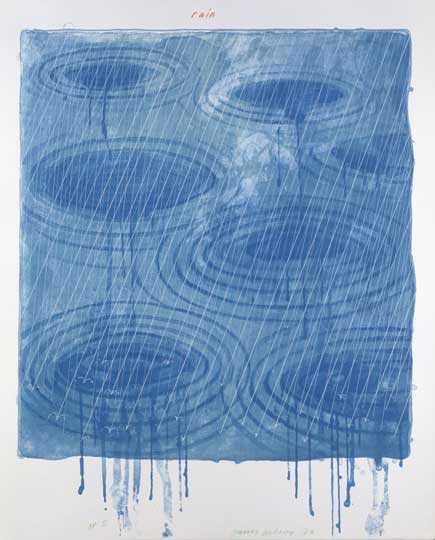In 1973, David Hockney embarked on a series of six colour lithographs, entitled The Weather Series. Each image depicts a weather condition: Rain, Lightning, Snow, Wind, Mist, Sunshine. As Hockney observed, however, in an interview with Ken Tyler, ‘the subject matter is really the weather drawn’, not just the weather itself.
In Mist – adamant that he would not spray it (‘you know, it’s too easy’) – Hockney conjures the haze with sponged and stippled pink, scattered with tangled strands of grey; in Snow, the softness of heaped snow is felt in the areas of un-inked paper: in Rain, the surface of the pool becomes the surface of the paper, the ripples bleeding blue ink into the bottom margin of the sheet. Where these prints evidence his sensitivity to the suggestive, material sympathies between technique and subject matter, in Wind, the wind makes itself known by whisking the other prints in Hockney’s series into the air and down Melrose Avenue, NYC: it is the levity with which Hockney references his own works that lifts the wind onto the paper and the print out of the realms of tired naturalism.
If the Royal Academy’s 2012 show situated Hockney in the gallery-going imagination as a gestural painter of bold, brash Yorkshire landscapes, this much smaller exhibition celebrates an artist of nervous energy and analytical precision: a printmaker of great technical skill and imagination. Grouped according to theme and technique, the works on show – created over a career of 60 years – demonstrate the wide scope of Hockney’s engagement and experimentation with the techniques of etching, aquatint and lithography.

Two Boys Aged 23 and 24 from Illustrations for Fourteen Poems from C.P. Cavafy (1966–7), David Hockney © the artist
Printmaking processes are unforgiving to the pedant: mistakes are hard to correct. What makes Hockney such an extraordinary printmaker is that, in him, an uninhibited spontaneity of touch is married to an eye as sharp as the engraver’s burin itself.
In his earliest etchings, produced as a student at the Royal College of Art, his line is agitation, frenzy. In Myself and My Heroes (1961) the image with which this exhibition opens, Hockney’s restless excitement with a new medium is tactile; Hockney looks on as Whitman and Ghandi look at one another, their scratched faces encircled by daubed, aquatint sun-halos. Each figure is identified with a caption – quotes for Whitman and Gandhi, and the prosaic descriptor –‘I am twenty-three years old and wear glasses’ – for Hockney himself.
The combination of effects is chiefly humorous, but the image also stands as a kind of artist’s proof, a testing ground for the ideas that would remain paramount throughout his career: a respect for the energy of line, which he would later distill to a tender economy in the homoerotic context of the Cavafy Suite (1966); a sense of the printed line’s sympathy with storytelling, conspicuous in his illustrations for Cavafy’s poems and Six Fairy Tales from The Brothers Grimm (1969); and perhaps chiefly, an insistence on his own presence. In each and every image in this exhibition, be it a portrait of Celia Birtwell or a vase washed in sunlight, the viewer cannot help but be impressed – in a way both tinglingly alienating and fundamentally engaging – with the awareness of seeing as Hockney sees.
Were a visitor to arrive at the Dulwich Picture Gallery, under the misapprehension that etching and lithography were techniques secondary to painting, whose purpose was the cheaper dissemination of an image, they would leave having had such a misconception blasted out of all being. Hockney’s prints compel and reward scrutiny, inspiring delight in, and admiration for, an artistic practice so routinely disregarded.
‘Hockney: Printmaker’ is on at the Dulwich Picture Gallery, London until 11 May 2014.
Unlimited access from just $16 every 3 months
Subscribe to get unlimited and exclusive access to the top art stories, interviews and exhibition reviews.





















![Masterpiece [Re]discovery 2022. Photo: Ben Fisher Photography, courtesy of Masterpiece London](http://www.apollo-magazine.com/wp-content/uploads/2022/07/MPL2022_4263.jpg)
It’s time for the government of London to return to its rightful home